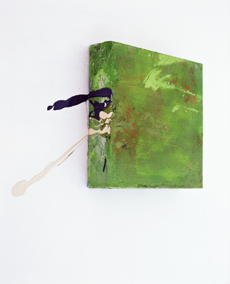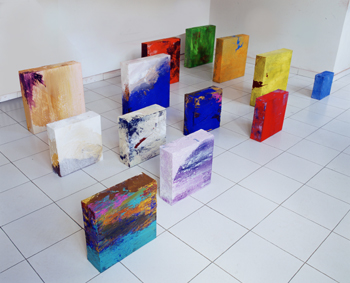Sala
ROBAYERA. Cantabria. from 07-15 to 08-15. 2006.
Alberto Reguera: Depth in the art of painting.
By Miguel Cereceda.
Rafael Canogar said in 2002 that Alberto Reguera was a sort of follower
or substitute of his artistic generation. This became evident in a joint
exhibition where a consummate artist came up with the idea of holding
an intergenerational dialogue with a promising talent in contemporary
art. I am interested in highlighting this relationship because it provides
some continuity to a tradition and has to do with the work of a young
artist who has been widely recognized. It does not mean, however, that
Alberto Reguera should be considered a pupil of Canogar or a follower
of his initial informalist work, although Reguera’s painting incorporates
many of Canogar’s traits. It actually means that Reguera has inherited
and willingly accepted to deal with most of the unresolved problems under
this tradition. What were the problems the previous generation left unresolved
and passed on to the next? Basically, those related to the relevance and
significance of painting. Alberto Reguera clearly said so at a conversation
with Rafael Canogar on the occasion of their joint exhibition:
Reguera: I think those who are involved in painting at this point in time
should be on the sidelines of any trend supporting the view that painting
is dead. To show that it is not, it is necessary to do a very good work.
Everything that is happening now may be due to the fact that there was
a time when there was a lot of painting, including some with little autonomy.
This is the moment of truth; the moment to say that a piece on display
can be as powerful as or even more powerful than an installation and vice-versa.
The form of presentation alone does not guarantee the quality of the work
of art; the very work does.
Canogar: Absolutely, quality is what matters. The fact that it is an installation
does not make it avant-gardist or modern. I am often asked to be a jury
member and I always say that there is nothing more horrible than a bad
abstract piece. I prefer an average figurative work because it shows something,
at least. The former is incredibly boring.
Reguera: Yes, it is annoying. That is why, painters should draw themselves
up to their full height. They should not do anything. Being a painter
today demands some commitment. When you go to a gallery in New York or
London, you see paintings reduced to fifteen or twenty percent of the
overall exhibit. Nevertheless, I feel painting will never die. This has
been witnessed even in the most difficult periods: painting is always
present; it never vanishes completely. Such a commitment to tradition
gives Alberto Reguera’s work certain serenity while in production,
a certain formal sobriety and a certain disdain for changing, fashionable
artistic trends. The funny thing is that this commitment does not come
from a material relationship with painting, but from an intellectual one.
In fact, the artist has not been trained in Fine Arts, something that
would have provided him with technique and craft, but in History of Art,
which helped him gain good knowledge of the great classical painters and
made him feel fascinated by 19th-century European painting. His fascination
covers both Romanticism and Impressionism. Alberto Reguera takes his early
passion for painting from these two traditions. His impressionist or informalist
pieces, as Juan Eduardo Cirlot called them at the time of Rafael Canogar’s
early works, clearly show the weight of romantic landscaping and the color
of impressionist landscaping. These early, seemingly abstract canvases
had, however, a deep, basic landscape feeling: sea, sky, earth and even
an inner voyage. Some of these pieces could be considered impressionist
and abstract, just as those by William Turner.

Reguera has since been interested in creating atmospheres. For this, it
is indispensable to deal with the problem of perspectivistic illusion,
that is to say, the problems of depth and color. This has traditionally
been the case in painting.
The problem of depth, said the artist, is one of my earliest problems.
Perspectivistic illusionism was present in every effort I made to produce
landscapes. Depth came next. The very overlapping of color layers introduced
a bizarre depth of surfaces. How could the deep appear in a play that
was purely superficial? In fact, the artist was not interested in pictorial
illusionism and the old problem of the visual window. He was really interested
in dealing with the problem of depth in painting or, better said, in going
deeper into painting itself.
At the beginning, he was concerned about the density of pigments. His
paints acquired a depth of their own as he applied them on a surface.
Material paints; earthy clouds; tactile, almost carnal qualities.
They had a body, a physique. Pigments brought along volume, space and
depth. That is why, the problem of space could never be reduced to the
problem of illusionist representation on a plane. It was no illusionism,
but something much deeper: the very depth of painting.
Nothing prevented the artist from moving out of the piece and painting
on sides and walls, or placing it on the floor to generate a new spatial
depth. This meant no transgression. Only under Greenbergian formalism,
painting was to be displayed exclusively on a plane. Expanding in space
and renouncing pictorial illusionism without moving away from the piece
itself were a new way of being faithful to painting. The idea was to stop
painting landscapes without leaving fundamental problems aside.
The same applied to color. It posed another fundamental problem. The artist
likes very much the idea of playing with colors. Sometimes, he deliberately
seeks sharp contrasts. Some other times, these contrasts appear in the
canvas and have to do with a dialogue that results from juxtaposing different
pieces.
Once in a while, a stain is left out of the canvas, on the wall. It ends
up giving the idea of an installation, in a pictorial sense at least.
Alberto Reguera’s installations always stem from a purely pictorial
need. His idea is to explore the many opportunities painting provides.
That is why, the painting goes out of the picture. In a way, it has no
beginning and end. Away from the restriction on the double dimension of
a plane, color undertakes a dialogue in the canvas and easily moves from
one canvas to another. Alberto Reguera likes to display his pictures as
if they were part of a family. He organizes them by forms and colors.
They are big and small, harmonic and contrasting, assonant and dissonant.
His need to expand color also led him to work on sides. The side ends
of his paintings were worked as painstakingly as the very core. He enjoyed
playing with contrasting light and color on side ends and their reflection
on a white wall. Painting the wall itself was just another step. This
somehow gives every piece a specific site and forces to photograph it
to establish its relationship with space. That is why, the side ends of
his paintings got bigger and wider. The idea was to increase space autonomy
and depth, and have new areas to color. Thus, his canvases or pieces on
lumber looked like objects or sculptures and, finally, like cubes. According
to the artist, they were not sculptures or installations, but pieces that
had been spatially displayed. His pieces, though they look like sculptures,
are not closed at the rear and are not painted either. They remain pieces.

It is possible, however, to group them by theme families. These families recreate the problem of perspectivistic depth on the one hand and that of dialogue and color contrast on the other. Sometimes, these installations are arranged as if they were truly families, in a comic and solemn manner, similar to Charles IV family, as portrayed by Goya. Some other times, his installations look like architectures, made up of urban or city blocks. All these appearances, however, are merely fortuitous and accidental. They just help build a possible dialogue. The artist always emphasizes that every piece should be considered autonomous, though it is part of a set when combined. A specific installation is just a specific arrangement. When viewers look at it from different angles, they can change the two fundamental variables in the work of art: perspectivistic depth and color relations. The installation will stay if the arrangement remains unchanged. It can be photographed to record its happening. In fact, Alberto Reguera takes many pictures of his different installations. Some of them are very interesting, but photography should not be taken as a fetish. The artist emphasizes that they are actually paintings and that his idea is always to go deeper into the art of painting.
Miguel Cereceda.
Rafael Canogar and Alberto Reguera, Relevos Exhibition, Social Work at
Madrid Bank, Museum of Fine Arts, Seville (Spain), February 26-April 21,
2002.
Rafael Canogar and Alberto Reguera, Mano a mano, Relevos Exhibition Catalogue,
cit. loc., no page number.
(Traslation by RIMEX.)